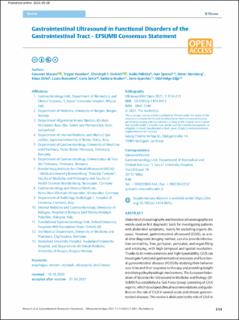Gastrointestinal Ultrasound in Functional Disorders of the Gastrointestinal Tract - EFSUMB Consensus Statement
| dc.contributor.author | Maconi, Giovanni | |
| dc.contributor.author | Hausken, Trygve | |
| dc.contributor.author | Dietrich, Christoph F. | |
| dc.contributor.author | Pallotta, Nadia | |
| dc.contributor.author | Sporea, Ioan | |
| dc.contributor.author | Nürnberg, Dieter | |
| dc.contributor.author | Dirks, Klaus | |
| dc.contributor.author | Romanini, Laura | |
| dc.contributor.author | Serra, Carla | |
| dc.contributor.author | Braden, Barbara | |
| dc.contributor.author | Spârchez, Zeno | |
| dc.contributor.author | Gilja, Odd Helge | |
| dc.date.accessioned | 2022-01-31T11:38:52Z | |
| dc.date.available | 2022-01-31T11:38:52Z | |
| dc.date.created | 2022-01-07T08:17:56Z | |
| dc.date.issued | 2021 | |
| dc.identifier.issn | 2199-7152 | |
| dc.identifier.uri | https://hdl.handle.net/11250/2975943 | |
| dc.description.abstract | Abdominal ultrasonography and intestinal ultrasonography are widely used as first diagnostic tools for investigating patients with abdominal symptoms, mainly for excluding organic diseases. However, gastrointestinal ultrasound (GIUS), as a real-time diagnostic imaging method, can also provide information on motility, flow, perfusion, peristalsis, and organ filling and emptying, with high temporal and spatial resolution. Thanks to its noninvasiveness and high repeatability, GIUS can investigate functional gastrointestinal processes and functional gastrointestinal diseases (FGID) by studying their behavior over time and their response to therapy and providing insight into their pathophysiologic mechanisms. The European Federation of Societies for Ultrasound in Medicine and Biology (EFSUMB) has established a Task Force Group consisting of GIUS experts, which developed clinical recommendations and guidelines on the role of GIUS in several acute and chronic gastrointestinal diseases. This review is dedicated to the role of GIUS in assisting the diagnosis of FGID and particularly in investigating patients with symptoms of functional disorders, such as dysphagia, reflux disorders, dyspepsia, abdominal pain, bloating, and altered bowel habits. The available scientific evidence of GIUS in detecting, assessing, and investigating FGID are reported here, while highlighting sonographic findings and its usefulness in a clinical setting, defining the actual and potential role of GIUS in the management of patients, and providing information regarding future applications and research. | en_US |
| dc.language.iso | eng | en_US |
| dc.publisher | Thieme Open | en_US |
| dc.rights | Attribution-NonCommercial-NoDerivatives 4.0 Internasjonal | * |
| dc.rights.uri | http://creativecommons.org/licenses/by-nc-nd/4.0/deed.no | * |
| dc.title | Gastrointestinal Ultrasound in Functional Disorders of the Gastrointestinal Tract - EFSUMB Consensus Statement | en_US |
| dc.type | Journal article | en_US |
| dc.type | Peer reviewed | en_US |
| dc.description.version | publishedVersion | en_US |
| dc.rights.holder | Copyright 2021. The Authors | en_US |
| cristin.ispublished | true | |
| cristin.fulltext | original | |
| cristin.qualitycode | 1 | |
| dc.identifier.doi | 10.1055/a-1474-8013 | |
| dc.identifier.cristin | 1976262 | |
| dc.source.journal | Ultrasound International Open | en_US |
| dc.source.pagenumber | 14-24 | en_US |
| dc.identifier.citation | Ultrasound International Open. 2021, 7 (1), 14-24. | en_US |
| dc.source.volume | 7 | en_US |
| dc.source.issue | 1 | en_US |
Tilhørende fil(er)
Denne innførselen finnes i følgende samling(er)
-
Department of Clinical Medicine [2095]
-
Registrations from Cristin [10412]

